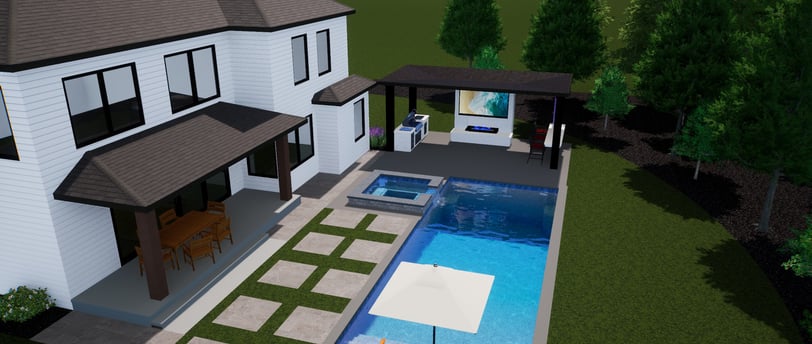The Cost of Running a Pool for a Swim Season and Choosing the Right Size Pool for Your Family
1/28/20244 min read


The Cost of Running a Pool for a Swim Season
Having a swimming pool in your backyard is a dream come true for many families. It provides a refreshing oasis during the hot summer months and a perfect space for relaxation and recreation. However, it is essential to consider the costs associated with owning and maintaining a pool before taking the plunge.
1. Initial Installation Costs
The first significant expense when considering a pool is the initial installation cost. The price can vary depending on the type, size, and features of the pool you choose. Here are some of the factors that can influence the cost:
Type of Pool: In-ground pools tend to be more expensive than above-ground pools due to the excavation and construction required.
Size and Shape: Larger and more complex pool designs will generally cost more.
Materials: The choice of materials, such as fiberglass, vinyl, or concrete, will affect the overall cost.
Additional Features: Features like waterfalls, slides, and lighting will add to the installation cost.
On average, you can expect to spend between $70,000 and $150,000 for a standard in-ground pool, while above-ground pools typically range from $2,500 to $15,000.
2. Regular Maintenance Costs
Once your pool is installed, you will need to consider the ongoing maintenance costs to keep it clean, safe, and functioning properly. Here are some of the regular expenses you can expect:
Chemicals: Pool chemicals, such as chlorine and pH balancers, are necessary to maintain water quality. The monthly cost for chemicals can range from $50 to $150, depending on the size of your pool and the local water conditions.
Electricity: Running the pool pump and filtration system requires electricity. On average, this can add around $30 to $50 to your monthly utility bill.
Water: Topping up the pool and replacing water due to evaporation or backwashing will contribute to your water bill. The cost will vary depending on the size of your pool and the local water rates.
Cleaning and Maintenance: Regular cleaning, vacuuming, and maintenance tasks can either be done by the pool owner or outsourced to a professional pool service. The cost will depend on the frequency of service and the complexity of the tasks involved.
It is estimated that the annual maintenance cost for a pool can range from $1,200 to $2,500, depending on the size and type of pool, as well as the level of service required.
3. Repairs and Upgrades
Over time, your pool may require repairs or upgrades. These costs can vary significantly depending on the extent of the damage or the desired enhancements. Some common repair and upgrade expenses include:
Leak Detection and Repair: If you notice a drop in water level, it may indicate a leak that needs to be repaired. The cost will depend on the size and location of the leak.
Pool Equipment Replacement: Pumps, filters, heaters, and other pool equipment have a lifespan and may need to be replaced after several years of use.
Resurfacing: Concrete pools may require resurfacing every 10 to 15 years, which can be a significant expense.
Upgrades: Adding new features or improving the pool's functionality, such as installing energy-efficient equipment or automation systems, will involve additional costs.
It is advisable to set aside a budget for repairs and upgrades, as these expenses can arise unexpectedly and vary depending on your specific pool and circumstances.
Choosing the Right Size Pool for Your Family
When it comes to selecting the right size pool for your family, several factors should be taken into consideration:
1. Available Space
Begin by assessing the available space in your backyard. Measure the area where you plan to install the pool and consider any other structures or landscaping elements you want to include. This will help determine the maximum size and shape of the pool that can comfortably fit in your yard.
2. Intended Use
Think about how your family intends to use the pool. Do you envision it as a space for leisurely swimming, entertaining guests, or as a focal point for activities such as water sports? The intended use will influence the size and shape of the pool you choose.
3. Number of Family Members
Consider the number of family members who will be using the pool regularly. If you have a large family or frequently entertain guests, a larger pool may be more suitable to accommodate everyone comfortably.
4. Budget
Set a budget for your pool project and consider the costs associated with installation, maintenance, and ongoing expenses. Remember that larger pools generally require more resources to maintain and operate.
5. Local Regulations
Check with your local authorities or homeowner's association regarding any regulations or permits required for pool installation. Some areas may have specific requirements regarding pool size, fencing, or safety features.
6. Seek Professional Advice
Consult with a professional pool builder or designer to discuss your specific needs and preferences. They can provide valuable insights and guide you through the process of selecting the right size pool for your family.
Ultimately, choosing the right size pool for your family involves finding a balance between available space, intended use, budget, and the number of family members. Taking the time to consider these factors will help ensure that your pool meets your family's needs and provides years of enjoyment.
Owning a pool can bring countless hours of fun and relaxation, but it is important to be aware of the associated costs and choose a pool size that suits your family's needs and budget. By considering the factors mentioned above, you can make an informed decision that will provide you with a pool that brings joy and memories for years to come. Check out our course on choosing the right pool builder for you or getting your backyard oasis designed specifically for you.
